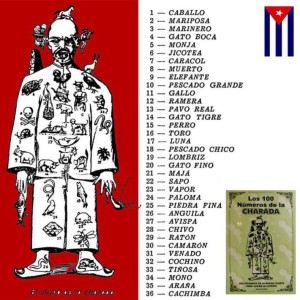“THE BOLITA” (Small Ball) and “LA CHARADA”: THE CHINESE IN CUBA.
Who does not remember the nursery rhyme that says “A Chinese fell into a well, water became guts”? Well known to the stage where the Chinese in Cuba were subjected to terrible conditions of exploitation, almost slavery, many not endured and to failure, mass suicide by jumping into wells were conducted … a fact that is collected naively that song … But this is not the issue that concerns us now, but also has a relationship with the Chinese. Let’s go back to the “vices” that brought the Chinese to Cuba and were taken by Cubans with great appetite.
In addition to lottery tickets, there was also the “ball” or “charade” of Chinese inspiration. Gambling that were part of Cuban culture. Especially the poorest, who are deluded by a stroke of luck and silver lined out of poverty.
The two complementary products and substitutes for the lottery are in Cuba and the pellet charade. The first has a different and own origin. But the ball is like an adopted daughter Lottery.
A statistic of 1957 which invested Cubans every year on lottery tickets, verses charade and hundreds and terminals ball says a fluctuating amount between $ 90 and $ 100 million. What were these games?
THE CHARADA:
Chinese settlers introduced in Cuba as the mid-nineteenth century (and on this we have published) says that the ones who spread the game of “paco tweet” and “cheffá” then called “charade”. The latter is a word of French origin and is like a type of riddle.
With the result that the charade, applied to the game, is a riddle which theoretically gives the track a number stored in an envelope and it hangs in view of the participants. The Kabbalistic symbolism of the charade comprises several animals or “bugs”, each of which corresponds a number. So when the envelope with the award-winning number has not yet been opened, it was said that “the bug is colgao.
How is it then played the charade? When you pull? What is gained?
He pulled-in various places- twice a day: afternoon and evening. It was played by “qt” (three cents or two numbers by half) they earn, when you leave the number, $ 1.50 although the public sometimes you are paid only $ 1.40.
The roll is made one or two hours before the ball to give players a chance to make a “pass” to the latter. Say the verse was “a girl who gives everything” and that there is a mortal happy engrampa 16 a quart. Then his prize ($ 1.40) or part thereof, in agreement with the intermediary bank apuntación is automatically invested in a number of the ball.
Parle:
The game of ball needed a fresh impetus, and benches achieved something in this direction by introducing the “parlé”.
The new way turned the ball into an instrument that proved its flexibility in the charade, entrenched in the traditional types. Of course the charade keeps his audience, because it gives you more chances to win the player, although premiums are lower.
In the charade there is usually thirty six numbers, then a roll several of them can be “prisoners”, so they were eliminated in the next draw and the number of chances to hit increases.
In the ball there are a thousand numbers. But you can play a “fixed” or a “run” a “hundred” or a “terminal” or several of them simultaneously.
A nickel, an “average” fixed to earn hundred twenty dollars, if it comes. And the “average” run five dollars.
Fixed is the number that appears in the first ball. Run any of the other two.
Even today many Cubans play the charade on the island. No SMS or Twitter, people manage to meet these and other issues that interest you. The peculiar way of communicating goes unnoticed for a stranger or a policeman. Now there are so many reservations. Amaro, a man between the ball and rum boot your money, every night on the wall of a shop in Causeway October 10, aims to chalk out the numbers.
And back again to the Chinese …
Many contributions of the Chinese in the melting pot that is Cuba. There is sufficient evidence that black and mulatto offspring had a spectacularly beautiful … plus the famous Ointment China and the Chinese Medical mythical, that is sure to dedicate a post. But for now let the Chinese …
MemoriasDeCuba / Derubín Jacomé / InternetPhotos / www.thecubanhistory.com
The Cuban History, Hollywood.
Arnoldo Varona, Editor.
“LA BOLITA” y “LA CHARADA”, LOS CHINOS EN CUBA.
¿Quién no recuerda la canción infantil que dice “Un chino cayó en un pozo, las tripas se hicieron agua”? Pues sepa que en la etapa en que los chinos en Cuba eran sometidos a condiciones tan terribles de explotación, casi de esclavitud, muchos no las soportaron y ante el fracaso, se realizaron suicidios colectivos lanzándose en pozos… hecho que se recoge ingenuamente en esa canción…
Pero este no es el tema que ahora nos atañe, aunque tenga relación también con los chinos. Vayamos de nuevo a los “vicios” que nos trajeron los chinos a Cuba y que fueron tomados por los cubanos con gran apetencia.
Además de los billetes de lotería, también existía la “bolita” o “charada” de inspiración china. Juegos de azar que formaban parte de la cultura del cubano. Sobre todo los más pobres, que se ilusionaban con un golpe de suerte y forrarse de plata para salir de la indigencia.
Los dos productos complementarios y sucedáneos de la lotería son en Cuba la charada y la bolita. La primera tiene un origen diferente y propio. Pero la bolita es algo así como una hija adoptiva de la Lotería.
Una estadística de 1957 de lo que invertían los cubanos todos los años en billetes de lotería, versos de la charada y centenas y terminales de la bolita, apunta una cifra fluctuante entre los $90 y los $100 millones. ¿En qué consistían estos juegos?
LA CHARADA :
Los chinos introducidos en Cuba como colonos a mediados del siglo XIX ( ya sobre esto hemos publicado) se dice que fueron los que expandieron el juego del “paco pío” y el “cheffá”, luego llamado “charada”. Esta última es una palabra de origen francés y viene a ser como un tipo de adivinanza.
De donde resulta que la charada, aplicada al juego, es una adivinanza que teóricamente da la pista de un número guardado en un sobre y que se cuelga a la vista de los participantes. El simbolismo cabalístico de la charada comprende varios animales o “bichos”, a cada uno de los cuales corresponde un número. Por eso, cuando el sobre con el número premiado aún no ha sido abierto, se decía que “el bicho está colgao.
¿Cómo se jugaba entonces a la charada? ¿Cuándo se tira? ¿Qué se gana?
Se tiraba—en diversos lugares— dos veces al día: por la tarde y por la noche. Se jugaba por “cuartillos” (tres centavos o dos números por un medio) que ganan, cuando sale el número, $1.50 aunque el público a veces sólo recibe como pago $1.40.
La tirada se efectúa una o dos horas antes de la bolita, para dar chance a los jugadores a efectuar un “pase” a esta última. Digamos que el verso era “una niña que todo lo brinda”, y que hay un feliz mortal que engrampa el 16 con un cuartillo. Entonces, su premio ($1.40) o parte de éste, previo acuerdo con el intermediario del banco de apuntación queda automáticamente invertido en un número de la bolita.
EL PARLÉ:
El juego de la bolita necesitaba un impulso renovador, y las bancas lograron algo en tal sentido al introducir el “parlé”.
La nueva forma convirtió la bolita en un instrumento que probó su flexibilidad sobre la charada, enquistada en los tipos tradicionales. Claro que la charada mantiene su público, porque le da más oportunidades de ganar al jugador, aunque los premios sean inferiores.
En la charada hay usualmente treinta y seis números, y luego de una tirada varios de ellos pueden quedar “presos”, de manera que se les elimina en el próximo sorteo y el número de probabilidades de acertar se incrementa.
En la bolita hay mil números. Pero se puede jugar a un “fijo” o a un “corrido”, a una “centena” o a un “terminal”, o a varios de ellos al mismo tiempo.
Una moneda de cinco centavos, un “medio”, fijo a la centena gana veinte pesos, si sale. Y el “medio”, corrido cinco pesos.
Fijo es el número que sale en la primera bolita. Corrido cualquiera de los otros dos.
Todavía hoy muchos cubanos juegan la Charada en la isla. Sin SMS, ni Twitter, la gente se las arregla para conocer estos y otros asuntos que le interesan. La peculiar forma de comunicarse pasa inadvertida para un extraño o un policía. Ahora no hay tantas reservas. Amaro, un hombre que entre la bolita y el ron bota su dinero, cada noche en la pared de una tienda en la Calzada 10 de Octubre, apunta con tiza los números que salieron.
Y volviendo de nuevo a los chinos…
Son muchas las aportaciones de los chinos en el crisol de culturas que es Cuba. Hay pruebas suficientes que con negras y mulatas dieron una descendencia de belleza espectacular… además de la famosa Pomada China y el mítico Médico Chino, al que de seguro dedicaremos una publicación. Pero por ahora dejemos a los chinos…
MemoriasDeCuba/Derubin Jacomé/InternetPhotos/www.thecubanhistory.com
The Cuban History, Hollywood.
Arnoldo Varona, Editor.





